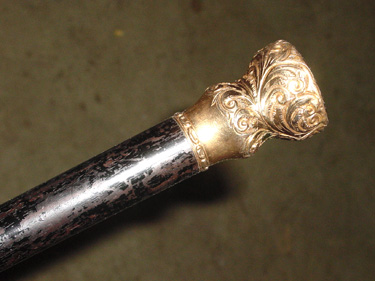
Boston Post Cane in Stow
A feature article in a recent issue of The Stow Independent honored Donald Brown as he celebrated his 104th birthday on Nov 26, 2012. At the 2007 COA Senior Picnic, he was presented with the Boston Post Cane. For those of you who don’t know what the Boston Post Cane is, this reprint of an Aug 13, 2008 article which tells how this strange tradition, which is at least 12 generations old in Stow, come about.
It all started back in 1909 as a gimmick by the now defunct Boston Post newspaper to increase circulation. They distributed gold-headed canes to the oldest town resident in selected New England towns. When that resident died, the cane was to be returned to the Selectmen to be given to the next oldest resident. Some say that Edwin Grazier, the publisher, picked the canes up cheap at auction. In the letter accompanying each cane, the Selectmen of the chosen towns were asked for the names of the “venerable men” who would receive them, along with biographical information and a photograph, if possible, for publication. He understood the value of a local story. The first article published was a brief profile of Solomon Talbot of Sharon. By 1930, when many women protested this implied injustice, the publisher of the Post announced that either a man or woman could hold the cane. It was reported that in 1960, only fourteen canes could be accounted for in New England.
Although it started as a gimmick, the practice of passing a gold-headed cane to the oldest town resident has become a tradition. There were 421 canes, made of African ebony with 14-carat rolled-gold heads. The cane tradition tapped into a vein of ritual and superstition as old as humanity. The cane, or staff, is an ancient symbol of deference to age and reverence for one’s ancestors. It is a fertility symbol as well; the passage of an ancient sacred staff from the oldest member of a group to the next, upon the first one’s death, is a way of defeating death. “The King is dead, long live the King.” It is therefore not surprising that such a piece of magic should become invested with superstition. Some people believed the cane was ‘hexed’. Residents who were hale and hearty when they received it were said to wither suddenly and die. Two men in Stow refused to accept it. “The kiss of death,” they said. “The cane does not represent death, but life,” proclaimed the Post in 1909.”
The tradition lapsed in Stow for a period of time. Around 1970, then Selectmen Roland Wright found the cane hiding in a corner of the town vault, learned about its history, and promptly had the Selectmen resume the tradition. The names of the cane precipitants in Stow from that time include Robert Swaney (died 1972 at 96), Emma Parker Scott (died 1973 at 96), Ida Neilson (died 1977), Theodore Mano (died 1980 at 93), Clifford Martin (died 1983 at 94), Eleanor L. Smith (died 1986 at 92), Leroy Gould (died 1987 at 97), Mary Mikijaniec (died 1990 at 95), Jennie M. Smith (died 1993 at 96), and Mabel Carvill (died 2006 at 97). Donald Brown is the current recipient (at 104).
To make sure that the cane doesn’t get accidentally lost, starting in 1987, the cane was placed back into the Town Vault and instead the recipient is presented with a Boston Post Cane lapel pin to proudly wear reminding people of the honor, and with the following Proclamation Certificate:
“Whereas the “Post Cane” was distributed in New England by Boston Post Newspaper in 1909, and whereas the Cane was intended to be presented to the oldest citizen of the Town, and whereas only a few of the original Canes are believed to remain in existence, and whereas the Selectmen wish to preserve Stow’s Post Cane while still carrying on the tradition, we, the Selectmen of Stow therefore proclaim that DONALD F. BROWN, who at age 99 is the oldest citizen of the Town Of Stow, and his name will be entered on the official list of recipients of the Post Cane.”